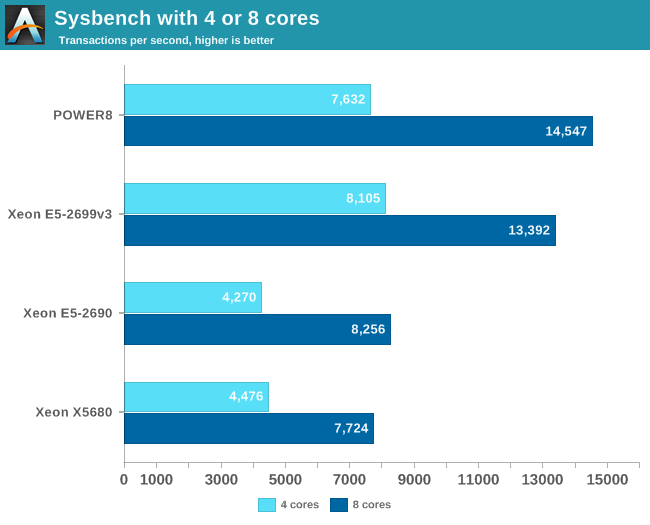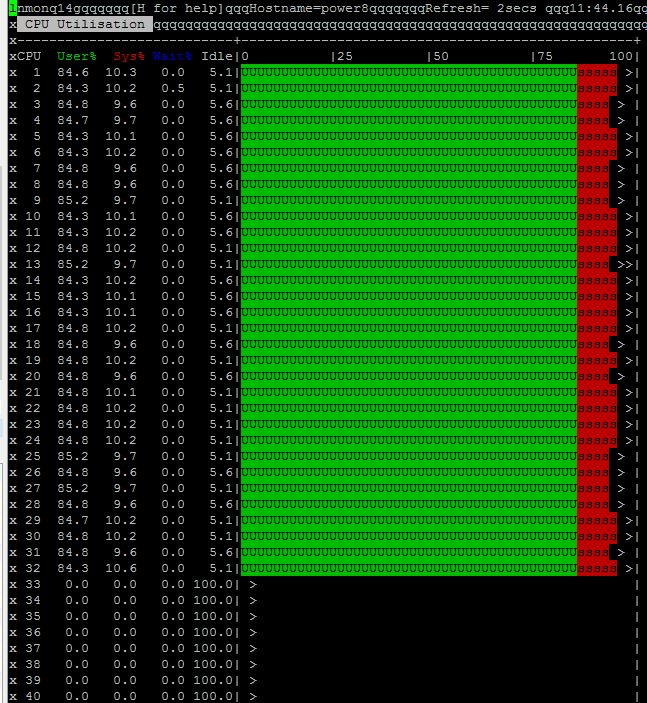The IBM POWER8 Review: Challenging the Intel Xeon
by Johan De Gelas on November 6, 2015 8:00 AM EST- Posted in
- IT Computing
- CPUs
- Enterprise
- Enterprise CPUs
- IBM
- POWER
- POWER8
Database Performance: MySQL
Both MySQL and PostgreSQL do not scale well enough to make use of 72 threads (Dual Xeon E5), let alone 160 threads (Dual POWER8). We installed Percona MySQL Server 5.6, which is the most scalable InnoDB based MySQL server.
We used the MySQL Sysbench benchmark, but we limited MySQL with taskset to run on 4 or 8 physical cores. We verified that this was actually the case by running "nmon" on top of the IBM server.
You can clearly see that the first 32 threads are used (CPU 0 - 7).
Sysbench allows us to place an OLTP load on a MySQL test database, and you can chose the regular test or the read-only test. We chose read only as even with solid state storage, Sysbench is quickly disk I/O limited.
We tested with 10 million records and 100,000 requests. The main reason why we tested with Sysbench is to get a huge amount of queries that only select very small parts (a few or one row) of the tables, Sysbench allows you to test with any number of threads you like, but there is no "think time" feature. That means all queries fire off as quickly as possible, so you cannot simulate "light" and "medium" loads.
The response times are very small, which is typical for an OLTP test. To take them into account, we are showing you the highest throughput at around 3-4 ms. As the results tend to vary a bit, we give you the average of three runs.

With only 4 cores active, the Xeon E5-2699 v3 is still running at 3.3 GHz. Once we use 8 cores, the clockspeed lowers to 2.9 GHz, and the POWER8 outperforms the best Xeon by a small margin. However, we are only testing a part of the CPUs, similar to running only one VM. Ultimately what this means is that total performance will be:
- the POWER8 will be around 36k (14400/8 * 20 cores)
- the Xeon E5-2699 v3 will be around 60k (13400/8 * 36 cores)
- the Xeon E5-2695 v3 will be around 45k (13000/8 * 28 cores)
So the current MySQL performance on top of POWER8 is good, but MySQL runs still a lot better on the Xeons.











146 Comments
View All Comments
Kevin G - Saturday, November 7, 2015 - link
If all you do is just mount the network volume to use the data, then likely nothing at all. While binaries do have to be modified, the file systems themselves are written to store data in a single consistent manner. If you're wondering more if there would be some overhead in translating from LE to BE to work in memory, conceptually the answer is yes but I'd predict it be rather small and dwarfed by the time to transfer data over a network. I'd be curious to see the results.Ultiamtely I'd be more concerned with kernel modules for various peripherals when switching between LE and BE versions. Considering that POWER has been BE for a few generations and you did your initial testing using LE, availability shouldn't be an issue. You've been using the version which should have had the most problems in this regard.
spikebike - Friday, November 6, 2015 - link
So basically power is somewhat competitive with intel's WORST price/perf chips which also happen to have the worst memory bandwidth/CPU. Seems nowhere close for the more reasonable $400-$650 xeons like the D-1520/1540 or the E5-2620 and E5-2630. Sure IBM has better memory bandwidth than the worst intels, but if you want more memory bandwidth per $ or per core then get the E5-2620.JohanAnandtech - Saturday, November 7, 2015 - link
It is definitely not an alternative for applications where performance/watt is important. As you mentioned, Intel offers a much better range of SKUs . But for transactional databases and data mining (traditional or unstructured), I see the POWER8 as very potent challenger. When you are handling a few hundreds of gigabytes of data, you want your memory to be reliable. Intel will then steer you to the E7 range, and that is where the POWER8 can make a difference: filling the niche between E5 and E7.nils_ - Wednesday, November 11, 2015 - link
Especially if you're running software that doesn't easily scale out very well these are very competitive. And nowadays even MySQL will scale-up nicely to many, many cores.Gigaplex - Friday, November 6, 2015 - link
"Less important, but still significant is the fact that IBM uses SAS disks, which increase the cost of the storage system, especially if you want lots of them."The Dell servers I've used had SAS controllers, and every SAS controller I've dealt with supported using SATA drives. I'm pretty sure SATA compatibility is in the SAS specification. In fact, the Dell R730 quoted in this review supports SAS drives. There shouldn't be anything stopping you from using the same drives in both servers.
JohanAnandtech - Saturday, November 7, 2015 - link
You are absolutely right about SATA drives being compatible with a SAS controller. However, afaik IBM gives you only the choice between their own rather expensive SAS drives and SSDs. And maybe I have looked over it, but in general DELL let you only chose between SATA and SSDs. And this has been the trend for a while: SATA if you want to keep costs low, SSDs for everything else.TomWomack - Sunday, November 8, 2015 - link
And mounting a storage server made out of commodity hardware over a couple of lanes of 10Gbit Ethernet if you don't want to pay the exotic-hardware-supplier's markup on disc.Gunbuster - Friday, November 6, 2015 - link
SAP and IBM AIX servers... I guess if you want to blow out your entire IT budget in once easy decision...Jake Hamby - Friday, November 6, 2015 - link
I forgot to mention: VMX is better known as AltiVec (it's also called "Velocity Engine" by Apple). It's a very nice SIMD extension that was supported by Apple's G4 (Motorola/Freescale 7400/7450) and G5 (IBM PPC 970) Macs, as well as the PPC game consoles.It would be interesting to compare the Linux VMX crypto acceleration to code written to use the newer native AES & other instructions. In x86 terms, it'd be like SSE-optimized AES vs. the AES-NI instructions.
Oxford Guy - Saturday, November 7, 2015 - link
I had a dual 450 MHz G4 system and AltiVec was quite amazing in iTunes when doing encoding. Between the second processor and the AltiVec putting things into ALAC was very fast (in comparison with other machines at the time like the G3 and the AMD machines I had).